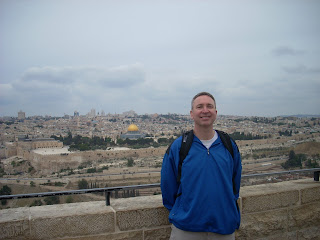
Most people suggest that if you are in old Jerusalem city you should take a taxi to the Mount of Olives, but I'm cheap, trying to get in shape for lots of hiking during my program, and I didn't have an appointment to keep, so I decided to walk there.
The Mount of Olives is east of Jerusalem on top of a significantly high hill, so it took some work. I started off from my hotel at the southwest side and walked on top of the walls of the city again starting from Jaffa Gate, this time heading in a different direction, clockwise around the city, traversing the western and northern walls, and ending at the eastern wall. From the eastern wall I headed out St. Stephen's Gate eastward toward the Mount.
From the old city heading east you descend into the Kidron Valley. As you approach the east side of the valley the first significant monument you see is the Church of All Nations, also known as the Church of the Agony because it is in tradition built over the rock in the Garden of Gethsemane on which Jesus prayed the night before he was arrested. In what remains of the Garden of Gethsemane there are a few olive trees, some very ancient. One thing I learned about the olive tree is that it is the only tree which you can not count the age by the rings of the tree because it rots from the inside out, and really old trees are hollow on the inside. There were a few really old olive trees next to the church, and from these trees there were younger trees that were literally growing from the inside of the older trees, kind of like a snake shedding its skin, only in this case it is a very, very slow process, a slow, but continual process. So, while the trees in this garden weren't literally there at the time of Jesus the roots were there and the trees would still be in the same spots as when Jesus was there.
After the Garden of Gethsemane and briefly peeking inside the church I made my way on a steep climb up the Mount of Olives. About halfway up the hill an Arab had a burro that you could hop on and ride the rest of the way up, but I'm not that old yet. On top of the Mount I had a conversation with Abraham, a Muslim who lived for a while in North Carolina. He wanted to sell me a picture of Jerusalem, but I wasn't buying. The crowd was thin at this point so we chatted for a while. He wasn't very interested in the gospel, but he was interested in telling me all about himself and in pointing out a few of the sites for me. I'm sure he just wanted to sell me something, but it was still good to visit with him.
There are some fantastic views of the old city from the Mount of Olives looking back westward. (see the picture above). Otherwise I didn't see that much up there. There isn't really much for archaeological remains on the Mount of Olives. Basically there are a number of churches commemorating various events of Jesus' time on the Mount of Olives. Scholars tell us that by the 6th century AD there were at least 24 churches built on the mount surrounded by monasteries filled with monks and nuns.
So, I headed back down the Mount making my way around the multitude of tombs on the side of the mountain. There are in fact thousands upon thousands of tombs up and down the mount and in the valley below because another name for the Kidron Valley is the Valley of Jehoshaphat which means “Yahweh Judges” in Hebrew. “Shaphat” is the Hebrew word for judge, and the first part of the word is God's name. In Joel 3 we read, “In those days and at that time, when I restore the fortunes of Judah and Jerusalem, I will gather all nations and bring them down to the Valley of Jehoshaphat. There I will enter into judgment against them concerning my inheritance, my people Israel, for they scattered my people among the nations and divided up my land” (Joel 3:1,2). One of the largest tombs in the valley is the Tomb of Beni Hezir, a wealthy Jewish priestly family, and was built about the 2nd century B.C..
After viewing this massive tomb I headed back up out of the Kidron Valley westward toward Jerusalem. Instead of following the road I decided to try a shortcut directly up a really steep hill. I did fine with the hill, but there were unfortunately slippery rocks punctuated here and there by a variety of local fauna and flora. The interesting thing was that I saw several different kinds of weeds and flowers that I had never seen before in our part of the world. One was a nasty cactus like kind of green plant, and I stayed a long ways away from that one. Unfortunately I managed to rub my legs against some kind of itch weed that had me scratching the whole rest of the way back. I jumped in the shower when I got back to the hotel room, washed off whatever oil was on my leg, and I was off again.

No comments:
Post a Comment